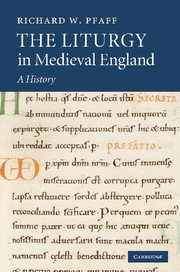Book contents
- Frontmatter
- Contents
- Preface
- Sigla and editorial conventions
- Bibliographical abbreviations
- Nicknames for manuscripts frequently referred to
- 1 Introduction
- Excursus: on sources
- 2 Early Anglo-Saxon England: a partly traceable story
- Excursus: on the terms Gregorian and Gelasian as used here
- 3 Later Anglo-Saxon: liturgy for England
- 4 The Norman Conquest: cross fertilizations
- Excursus: on method in the comparison of liturgical texts
- 5 Monastic liturgy, 1100–1215
- Excursus: on ascription of liturgical books to specific churches
- 6 Benedictine liturgy after 1215
- 7 Other monastic orders
- 8 The non-monastic religious orders: canons regular
- 9 The non-monastic religious orders: friars
- Excursus: on liturgical books from female religious houses
- 10 Old Sarum: the beginnings of Sarum Use
- 11 New Sarum and the spread of Sarum Use
- 12 Exeter: the fullness of secular liturgy
- 13 Southern England: final Sarum Use
- 14 Regional Uses and local variety
- 15 Towards the end of the story
- Index of Manuscripts
- Index of Saints
- General Index
14 - Regional Uses and local variety
Published online by Cambridge University Press: 20 March 2010
- Frontmatter
- Contents
- Preface
- Sigla and editorial conventions
- Bibliographical abbreviations
- Nicknames for manuscripts frequently referred to
- 1 Introduction
- Excursus: on sources
- 2 Early Anglo-Saxon England: a partly traceable story
- Excursus: on the terms Gregorian and Gelasian as used here
- 3 Later Anglo-Saxon: liturgy for England
- 4 The Norman Conquest: cross fertilizations
- Excursus: on method in the comparison of liturgical texts
- 5 Monastic liturgy, 1100–1215
- Excursus: on ascription of liturgical books to specific churches
- 6 Benedictine liturgy after 1215
- 7 Other monastic orders
- 8 The non-monastic religious orders: canons regular
- 9 The non-monastic religious orders: friars
- Excursus: on liturgical books from female religious houses
- 10 Old Sarum: the beginnings of Sarum Use
- 11 New Sarum and the spread of Sarum Use
- 12 Exeter: the fullness of secular liturgy
- 13 Southern England: final Sarum Use
- 14 Regional Uses and local variety
- 15 Towards the end of the story
- Index of Manuscripts
- Index of Saints
- General Index
Summary
York Use
What was known in the later middle ages as the Use of York differs in kind from that of Sarum in that it refers to the metropolitical church – York Minster, in common parlance – of the province, whereas Salisbury was just one of fourteeen cathedral churches in the province of Canterbury. The province of York was not at all like its southern neighbor. For one thing, it was vastly smaller, in terms both of population and of having only three dioceses: York itself; Carlisle, where a modest Augustinian priory founded around 1123 received cathedral status some ten years later; and Durham, monastic (from 1083), wealthy, powerful, jealous of its dignity and prerogatives. Durham stood also as a bastion, ecclesiastical and otherwise, of English presence in the unclear and often controverted border region with Scotland: expressed in terms of early Anglo-Saxon kingdoms, Durham came to stand for the old north-facing Bernicia, York for the south-facing Deira of which it had always been the center. Not surprisingly, then, some liturgical tension can be discerned between York and Durham; for example, a few secular service books used in the latter diocese follow Sarum rather than York use.
York stands in some tension also with Canterbury. This is reflected obviously in the primacy struggle between the two archbishoprics, a struggle that did not finally end (with Canterbury the victor) until the fourteenth century. More obvious liturgically is York's comparative deficiency in saints.
- Type
- Chapter
- Information
- The Liturgy in Medieval EnglandA History, pp. 445 - 528Publisher: Cambridge University PressPrint publication year: 2009



